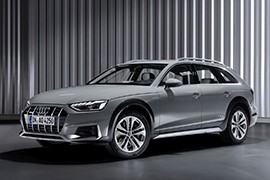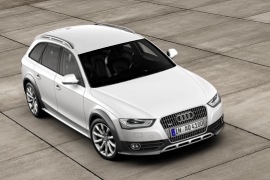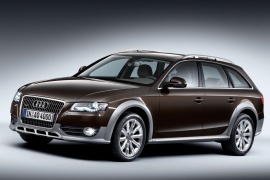AUDI A4 Allroad Models/Series Timeline, Specifications & Photos
First production year: 2009
Engines: Gasoline, Diesel
Body style: Wagon (station wagon, estate, combi, touring)
After ten years of off-roading experience with the first model, Audi released the facelift version of the second generation A4 Allroad Quattro in 2019.
Inheriting Audi A4 Avant's practical spirit and comfort, the car has some off-road oriented modifications that form a vehicle that performs well on and off the road.
The wagon is propelled by a 2.0-liter TFSI engine paired with a seven-speed S tronic automatic transmission and provides a considerable power output while still averaging a relatively small fuel consumption. Thanks to a Quattro drive system, the power is distributed to all the wheels.
Besides the widening of the track, the A4 Allroad Quattro also benefits from increased ground clearance. The raised ride height and the larger wheels make this model stand 1.4 inches (35 mm) higher than the Avant version. There is also an optional suspension with damper control managed by the Electronic Chassis Platform (ECP).
Audi adjusted the exterior design to provide a more robust look to differentiate the Allroad Quattro from the Avant and highlight its off-road capabilities. These design features include the front and rear bumpers, wide wheel arch trims, and side sill, all in a color called Structured gray. Optionally, the German automaker offers them in Manhattan gray or in the body color, with silver inlays available for the sills.
The underbody protection shines in silver, while the diffuser insert is finished in matte black to provide some contrast. The look is completed by the raised roof rails that provide increased practicality as they enable cargo to be loaded onto the roof.
The interior design is identical to the Avant version as it can be equipped with Basic, Design Selection, and S Line package lines. Audi chose to remain with the same interior as it has increased quality and can provide enough comfort even in off-road conditions.
To provide a versatile driving experience, the car lets the driver select from profiles such as Comfort, Auto, Dynamic, Efficiency, Individual, and Offroad. Choosing the Offroad profile converts all the systems to an off-road mode and combines functions like traction control, stabilization control, ABS, and hill descent control.
The electrically operated tailgate is marked with an "allroad" logo to provide a distinctive look for the car's rear end. It reveals a trunk with a capacity of 17.5 cubic feet (495 liters). Optionally, the Audi can be equipped with sensor control, a swivel trailer hitch, a folding mat, and a load-securing kit with a rail system to increase functionality.
On the road, the Audi A4 Allroad Quatro is a wagon that can offer much comfort and stability while having increased space for passengers and cargo. It can perform well off the road and is built to turn from a family car into an off-road vehicle quickly.
AUDI A4 Allroad quattro 2.0L TFSI quattro S tronic 7AT (245 HP)
In 2011, Audi introduced a facelift for the entire A4 range, which included improvements in more areas, not just outside.
A crossover built on the base of a station-wagon was not a new idea. Audi used it before on the A6 Allroad Quattro, and AMC did that in 1987 for the Eagle model. While some were nice additions on the market and were really useful if the owner had a lodge in the mountains, others were just sidewalk crawlers and mall-roaders. The A4 Allroad Quattro was too big to pass as a compact station wagon and too small to be useful in the mountains, but it was a good all-around vehicle.
With its higher ground clearance, the Allroad version tried to make a good impression on the Audi stand at the 2011 Frankfurt Motorshow. Its new headlights with the slim daytime running lights strips and the silver, single-frame grille at the front screamed for attention. The carmaker installed a new set of underbody protections, but since they were made out of plastic, those were there mostly for their look.
Inside, Audi offered a wide selection of steering wheels with chrome and high-gloss inlays. The MMI (multimedia interface) featured only four buttons instead of eight as before, and seven speakers for the standard version. Fortunately, the carmaker left the volume knob in place, still between the front seats.
The German carmaker improved the car on the technical side, with a new electromechanical power steering. For the V6 engined version, the A4 Allroad featured a sport rear differential on the options list.
AUDI A4 Allroad 2.0L TDI Quattro 6MT AWD (136 HP)
AUDI A4 Allroad 2.0L TDI Quattro 6MT AWD (143 HP)
AUDI A4 Allroad 2.0L TDI Quattro 6MT AWD (170 HP)
AUDI A4 Allroad 2.0L TDI Quattro 6MT AWD (177 HP)
AUDI A4 Allroad 2.0L TDI Quattro 7AT AWD (163 HP)
AUDI A4 Allroad 2.0L TDI Quattro 7AT AWD (177 HP)
AUDI A4 Allroad 3.0L TDI Clean Diesel Quattro 7AT AWD (245 HP)
Audi scored a big success with the A6 Allroad back in 1999, and the management thought that it might get the same result with a smaller brother, the A4 Allroad.
In 2009, the German carmaker introduced the A4 Allroad on the market. It was, basically, an A4 on stilts. The station-wagon already had an all-wheel-drive system. All it needed to become a compact crossover was higher ground clearance. At least, that's what the marketing department thought. The engineers started to work, the design team enhanced the car's look, and the result was not as good as expected.
Apart from the basic bodywork of an A4 Avant (that's Audi's designation for station-wagons), the Allroad version featured plastic moldings on the wheel arches, side sills, and lower bumpers. They were colored either gray or dark gray, depending on the vehicle's color. A set of aluminum roof-rails was fitted as standard. In the back, a small roof-spoiler enhanced the look of the rear end, together with a plastic skid plate under the bumper.
Inside, it was just a regular Audi A4 Avant. The instrument cluster was extended over the center console and included the infotainment screen. It was curved toward the driver to amplify the driving sensations. A mix of aluminum, leather, and wood-trims enhanced the car's interior look. Between the tachometer and speedometer, Audi installed a small TFT screen for the on-board computer.
Under the hood, the Germans planted a choice of five engines paired either with a 6-speed manual or a 7-speed automatic (dual-clutch).


